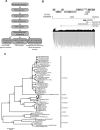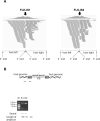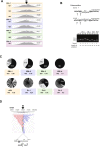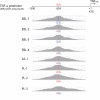A target enrichment high throughput sequencing system for characterization of BLV whole genome sequence, integration sites, clonality and host SNP
- PMID: 33633166
- PMCID: PMC7907107
- DOI: 10.1038/s41598-021-83909-3
A target enrichment high throughput sequencing system for characterization of BLV whole genome sequence, integration sites, clonality and host SNP
Abstract
Bovine leukemia virus (BLV) is an oncogenic retrovirus which induces malignant lymphoma termed enzootic bovine leukosis (EBL) after a long incubation period. Insertion sites of the BLV proviral genome as well as the associations between disease progression and polymorphisms of the virus and host genome are not fully understood. To characterize the biological coherence between virus and host, we developed a DNA-capture-seq approach, in which DNA probes were used to efficiently enrich target sequence reads from the next-generation sequencing (NGS) library. In addition, enriched reads can also be analyzed for detection of proviral integration sites and clonal expansion of infected cells since the reads include chimeric reads of the host and proviral genomes. To validate this DNA-capture-seq approach, a persistently BLV-infected fetal lamb kidney cell line (FLK-BLV), four EBL tumor samples and four non-EBL blood samples were analyzed to identify BLV integration sites. The results showed efficient enrichment of target sequence reads and oligoclonal integrations of the BLV proviral genome in the FLK-BLV cell line. Moreover, three out of four EBL tumor samples displayed multiple integration sites of the BLV proviral genome, while one sample displayed a single integration site. In this study, we found the evidence for the first time that the integrated provirus defective at the 5' end was present in the persistent lymphocytosis cattle. The efficient and sensitive identification of BLV variability, integration sites and clonal expansion described in this study provide support for use of this innovative tool for understanding the detailed mechanisms of BLV infection during the course of disease progression.
Conflict of interest statement
The authors declare no competing interests.
Figures




Similar articles
-
Comprehensive Comparison of Novel Bovine Leukemia Virus (BLV) Integration Sites between B-Cell Lymphoma Lines BLSC-KU1 and BLSC-KU17 Using the Viral DNA Capture High-Throughput Sequencing Method.Viruses. 2022 May 7;14(5):995. doi: 10.3390/v14050995. Viruses. 2022. PMID: 35632737 Free PMC article.
-
Diagnosis and Early Prediction of Lymphoma Using High-Throughput Clonality Analysis of Bovine Leukemia Virus-Infected Cells.Microbiol Spectr. 2022 Dec 21;10(6):e0259522. doi: 10.1128/spectrum.02595-22. Epub 2022 Oct 13. Microbiol Spectr. 2022. PMID: 36227090 Free PMC article.
-
Monoclonal proliferation of B-cells with two integration sites of bovine leukemia virus proviral DNA in cattle with enzootic bovine leukosis.J Vet Med Sci. 2024 Jun 1;86(6):653-655. doi: 10.1292/jvms.24-0037. Epub 2024 Apr 16. J Vet Med Sci. 2024. PMID: 38631888 Free PMC article.
-
Viral oncogenesis of δ-retroviruses, HTLV-1 and BLV, and recent advances in its diagnosis.Virology. 2025 Apr;605:110461. doi: 10.1016/j.virol.2025.110461. Epub 2025 Feb 21. Virology. 2025. PMID: 40015031 Review.
-
Epidemiology and genetic diversity of bovine leukemia virus.Virol J. 2017 Nov 2;14(1):209. doi: 10.1186/s12985-017-0876-4. Virol J. 2017. PMID: 29096657 Free PMC article. Review.
Cited by
-
Clone Dynamics and Its Application for the Diagnosis of Enzootic Bovine Leukosis.J Virol. 2023 Jan 31;97(1):e0154222. doi: 10.1128/jvi.01542-22. Epub 2022 Dec 19. J Virol. 2023. PMID: 36533951 Free PMC article.
-
Target Enrichment Metagenomics Reveals Human Pegivirus-1 in Pediatric Hematopoietic Stem Cell Transplantation Recipients.Viruses. 2022 Apr 12;14(4):796. doi: 10.3390/v14040796. Viruses. 2022. PMID: 35458526 Free PMC article.
-
Phylogenomics and Spatiotemporal Dynamics of Bovine Leukemia Virus Focusing on Asian Native Cattle: Insights Into the Early Origin and Global Dissemination.Front Microbiol. 2022 Jun 24;13:917324. doi: 10.3389/fmicb.2022.917324. eCollection 2022. Front Microbiol. 2022. PMID: 35814709 Free PMC article.
-
Comprehensive Comparison of Novel Bovine Leukemia Virus (BLV) Integration Sites between B-Cell Lymphoma Lines BLSC-KU1 and BLSC-KU17 Using the Viral DNA Capture High-Throughput Sequencing Method.Viruses. 2022 May 7;14(5):995. doi: 10.3390/v14050995. Viruses. 2022. PMID: 35632737 Free PMC article.
-
The Prevalence and Molecular Characterization of Bovine Leukemia Virus among Dairy Cattle in Henan Province, China.Viruses. 2024 Aug 31;16(9):1399. doi: 10.3390/v16091399. Viruses. 2024. PMID: 39339874 Free PMC article.
References
MeSH terms
LinkOut - more resources
Full Text Sources
Other Literature Sources

